Topics
- Monsoon
- Sustainable Development Goals
- Model Tenancy Act
- Shanghai Cooperation Organisation (SCO)
- Black Carbon
- SARS -CoV2
- Monsoon
Context: Southwest monsoon makes onset over Kerala on June 3.
Key Details:
- The India Meterological Department said the monsoon set in over southern parts of Kerala on June 3rd.
- The normal date for the onset of the monsoon over the Kerala coast is June 1st.
- The southwest monsoon arrived over the Andaman Sea on May 21, but did not progressed further.
- After its onset over Kerala, the monsoon spreads over the entire country by July 15.
- After two years of above-average rainfall, the IMD, in its second long-range forecast, has predicted normal monsoon rainfall at 101% of the long-period average (LPA) this year.
- In 2020 and 2019, the monsoon was above normal at 110% and 109% of LPA.
What does the ‘onset of monsoon’ mean?
- The onset of the monsoon over Kerala marks the beginning of the four-month, June-September southwest monsoon season over India, which brings more than 70 per cent of the country’s annual rainfall. The onset is a big day for the Indian economy every year.
- The arrival of monsoon, crucial to the country’s farm-dependent economy, is announced by IMD based on factors such as wind speed, consistency of rainfall, intensity, and cloud cover.
Factors influencing the onset on Southwest Monsoon:
The onset needs a trigger in the form of a weather system in the proximity of the coastline. These are ocean born phenomena which accentuate the monsoon surge around the normal time of onset. These include:
- The low-pressure area or depression in the Bay of Bengal during the last days of May or the beginning of June.
- There are such systems in the Arabian Sea as well around the same time which results in onset over the mainland.
- ‘Cyclonic Vortex’ is another factor which appears in the Southeast Arabian Sea, off Kerala and Lakshadweep region. They also shift along the west coast to push the monsoon current.
- The formation of ‘trough’ off the west coast due to temperature differential between land and sea. This situation could be for a mild start and weak progress.
- Lastly the cross-equatorial flow, wherein the trade winds from the Southern Hemisphere crossover to the Northern Hemisphere can bring a strong monsoon surge towards the Indian mainland.
Monsoon In India:
- Monsoons are seasonal winds which reverse their direction with the change of season.
- Generally, across the world, the monsoons are experienced in the tropical area roughly between 20° N and 20° S.
- The climate of India is described as the ‘monsoon’ type. In Asia, this type of climate is found mainly in the south and the southeast.
- Out of a total of 4 seasonal divisions of India, monsoon occupy 2 divisions, namely.
- The southwest monsoon season – Rainfall received from the southwest monsoons is seasonal in character, which occurs between June and September.
- Cause: Intense low-pressure formation over the Tibetan Plateau because of intense heating during the summer season; permanent high-pressure cell in the South of the Indian Ocean (East to Northeast of Madagascar in summer).
- The retreating monsoon season – The months of October and November are known for retreating monsoons.
Impact of Monsoons on Life in India
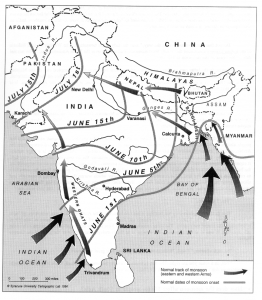
- About 64% of people in India depend on agriculture for their livelihood and agriculture itself is based on monsoon.
- Agricultural prosperity of India depends very much on timely and adequately distributed rainfall. If it fails, agriculture is adversely affected particularly in those regions where means of irrigation are not developed.
- Regional variations in monsoon climate help in growing various types of crops.
- Regional monsoon variation in India is reflected in the vast variety of food, clothes and house types.
- Monsoon rain helps recharge dams and reservoirs, which is further used for the generation of hydro-electric power.
- Winter rainfall by temperate cyclones in north India is highly beneficial for Rabi crops.
Long Period Average (LPA):
- The LPA is the average rainfall (88cm) recorded in India every year between June and September from 1961 to 2010.
- It is kept as a benchmark while forecasting the quantitative rainfall for the monsoon season every year.
Categories: IMD maintains five rainfall distribution categories on an all-India scale which are –
Excess: If the rainfall is more than 110 % of this LPA.
Above Normal: If the rainfall is between 104 and 110 % of this LPA.
Normal: If the rainfall is between 96 and 104 % of this LPA.
Below Normal: If the rainfall is between 90 and 96 % of this LPA.
Deficient: If the rainfall is less than 90 % of this LPA.
- Sustainable Development Goals
Context: 3rd rendition of Sustainable Development Goals (SDG) India Index 2020-21 was recently released.
Key Details:
Kerala has retained the top rank, while Bihar was ranked as the worst performer in NITI Aayog’s SDG India Index 2020-21.
- Mizoram, Haryana, and Uttarakhand are the top gainers in terms of improvement in their rankings from 2019.
- Second best performers: Himachal Pradesh and Tamil Nadu.
- Worst performing States besides Bihar: Jharkhand and Assam
- Chandigarh maintained its top spot among the UTs followed by Delhi.
- India bettered its Sustainable Development Goal score, climbing 6 points from 60 in 2019 to 66 in 2021. The improvement comes as a result of improvement in two key areas — clean water and sanitation and affordable and clean energy.
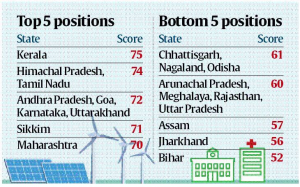

About Sustainable development Goals India Index:
- The SDG India Index was developed by Niti Aayog in collaboration with the Ministry of Statistics & Programme Implementation (MoSPI), Global Green Growth Institute and United Nations in India.
- The Index for Sustainable Development Goals (SDGs) evaluates progress of states and Union Territories on various parameters including health, education, gender, economic growth, institutions, climate change and environment.
- First launched in December 2018, the index has become the primary tool for monitoring progress on the SDGs in the country and has simultaneously fostered competition among the states and union territories by ranking them on the global goals.
Why does the index matter?
- It is a primary tool for monitoring progress on the SDGs in India.
- It fosters competitive spirit among the states and UTs
- The index has been successful as an advocacy tool to propagate sustainability, resilience, and partnerships.
- The index represents the articulation of the comprehensive nature of the Global Goals under the 2030 Agenda while being attuned to the national priorities.
What is Sustainable Development?
- ‘Development which meets the needs of the present without compromising the ability of future generations to meet their own needs’.
- This most widely accepted definition of Sustainable Development was given by the Brundtland Commission in its report Our Common Future (1987).
- Sustainable development (SD) calls for concerted efforts towards building an inclusive, sustainable and resilient future for people and planet
The Sustainable Development Goals or Global Goals:
- Set up by United Nations General Assembly in 2015, they are a collection of 17 interlinked global goals.
- They are designed to be a “blueprint to achieve a better and more sustainable future for all”.
- Target to achieve the goals: 2030.
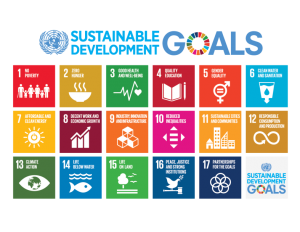
- Model Tenancy Act
Context: The Union Cabinet has approved the Model Tenancy Act to be sent to the States and Union Territories to enact legislation or amend laws on rental properties.
- States can adopt the Act as it is with fresh legislation, since it is a state subject, or they can amend their existing rent acts to factor in the new MTA.
- States and Union Territories have MoUs with the Centre under the Pradhan Mantri Awas Yojana-Urban which has this provision.
Salient Features of the act:
- The draft Act had been published by the Ministry of Housing and Urban Affairs in 2019.
- The Model Tenancy Act will provide a model for urban and rural properties, as well as a template for residential and commercial properties.
- It is Mandatory for there to be a written agreement between the property owner and the tenant.
- In case of dispute between landlord and tenant, a rent authority, or a rent court would be available for speedy resolution.
- A tenant will have to submit a security deposit of two months for residential premises. For commercial property, a tenant will have to pay six-month rent.
- The tenant cannot sublet a part of or the whole property to someone else.
- If the tenant fails to vacate the premises on the expiration of the period of tenancy or termination of tenancy, the landlord is entitled to double the monthly rent for two months and four times after that.
- The landowner would give a notice in writing three months before revising rent. The landlord cannot hike the rent in the middle of the tenure.
Coverage:
- It will apply to premises let out for residential, commercial or educational use, but not for industrial use.
- It also won’t cover hotels, lodging houses, inns, etc.
- It will be applied prospectively and will not affect existing tenancies.
- The Act seeks to cover urban and as well as rural areas.
Why this Act: Need and Significance:
- As per Census 2011, more than 1 crore houses were lying vacant in urban areas. The existing rent control laws are restricting the growth of rental housing and discourage owners from renting out their vacant houses due to fear of repossession.
- One of the potential measures to unlock the vacant house is to bringing transparency and accountability in the existing system of renting of premises and to balance the interests of both the property owner and tenant in a judicious manner.
- The Act aims to bridge the trust deficit between tenants and landlords by clearly delineating their obligations.
- Besides, The Act is expected to give a fillip to private participation in rental housing as a business model for addressing the huge housing shortage.
- Young, educated job seekers migrating to large metropolises often complain of onerous tenancy conditions and obscene sums of money as security deposits that they are asked to fork out to lease accommodation. In some cities, tenants are asked to pay security deposits amounting to 11 months of rent.
- Also, some house owners routinely breach tenants’ right to privacy by visiting the premises unannounced for sundry repair works.
- Whimsical rent raises are another problem for tenants, many of whom complain of being squeezed as “captive customers“.
- Besides, Tenants are often accused of “squatting” on the rented premises, or trying to grab the property.
Challenges:
- The Act is not binding on the states as land and urban development remain state subjects.
- Like in the case with RERA (Real Estate (Regulation and Development Act), the fear is that states may choose not to follow guidelines, diluting the essence of the Model Act.
- Shanghai Cooperation Organisation (SCO):
Context: The Union Cabinet of India has approved the ratification of an Agreement on “Cooperation in the field of Mass Media” between all the Member States of Shanghai Cooperation Organisation.
Key Details:
- The Agreement was signed in June 2019. It will provide an opportunity for the Member States to share new innovations and best practices in the field of Mass Media.
- The agreement aims to promote equal and mutually beneficial cooperation among associations in the field of mass media.
- The main areas of cooperation in the agreement are the creation of favourable conditions for the wide and mutual distribution of information through mass media in order to further deepen the knowledge about the lives of the peoples of their states.
- The agreement shall promote equal and mutually beneficial cooperation among professional associations of journalists of the states in order to study the available professional experience, as well as to hold meetings, seminars and conferences.
- It will help in aiding broadcast of television and radio programs and those distributed legally within the territory of the State.
- Also in encouraging the exchange of specialists and experience in the field of Mass Media, offer mutual assistance in training media professionals, and promote cooperation between scientific research and educational institutions in the field of Mass Media.
About Shanghai Cooperation Organisation (SCO):
- It is a permanent intergovernmental international organisation.
- It’s a Eurasian political, economic and military organisation aiming to maintain peace, security and stability in the region.
- It’s creation was announced on 15 June 2001 in Shanghai (China) by the Republic of Kazakhstan, the People’s Republic of China, the Kyrgyz Republic, the Russian Federation, the Republic of Tajikistan, and the Republic of Uzbekistan.
- It was preceded by the Shanghai Five mechanism.
- The Shanghai Cooperation Organisation Charter was signed during the St.Petersburg SCO Heads of State meeting in June 2002, and entered into force on 19 September 2003.
- The SCO’s official languages are Russian and Chinese.
- The Chairmanship of SCO is by rotation for a year by Member States.
- The organisation has two permanent bodies:
- The SCO Secretariat based in Beijing.
- The Executive Committee of the Regional Anti-Terrorist Structure (RATS) based in Tashkent.
- The Heads of State Council (HSC) is the supreme decision-making body in the SCO. It meets once a year and adopts decisions and guidelines on all important matters of the organisation.
- Membership:
- Eight member states: India, Kazakhstan, China, Kyrgyzstan, Pakistan, Russia, Tajikistan, and Uzbekistan.
- Four observer states: Afghanistan, Belarus, Iran and Mongolia
The SCO’s main goals are as follows:
Strengthening mutual trust and neighbourliness among the member states; promoting their effective cooperation in politics, trade, the economy, research, technology and culture, as well as in education, energy, transport, tourism, environmental protection, and other areas; making joint efforts to maintain and ensure peace, security and stability in the region; and moving towards the establishment of a democratic, fair and rational new international political and economic order.
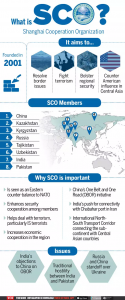
- Black Carbon
Context: According to recently released World Bank Study, Black carbon deposits are accelerating glaciers and snow melt in Himalayan ranges.
About:
- The world Bank Study covers the Himalaya, Karakoram and Hindu Kush (HKHK) mountain ranges.
- As per the study, glaciers are melting faster than the global average ice mass in these ranges.
- The rate of retreat of HKHK glaciers is estimated to be 0.3 metres per year in the west to 1.0 metre per year in the east.
- Black carbon deposits due to human activities are accelerating glaciers and snow melt in the fragile Himalayan ranges and are changing temperatures and precipitation patterns.
- Air temperature Deposits of BC act in two ways hastening the pace of glacier melt:
- By decreasing surface reflectance of Sunlight.
- By raising air temperature.
- Recent evidence suggests that in addition to changing temperatures and precipitation patterns, anthropogenic black carbon (BC) deposits – soot – are further accelerating glacier and snow melt in these mountain ranges.
- It is generated by human activity both inside and outside South Asia. It is part of a larger basket of aerosols that impact climate change directly and indirectly.
- The study provides new evidence on the extent to which black carbon reduction policies by South Asian countries have an impact on glacier formation and melt in the Himalaya, Karakoram, and Hindu Kush mountain ranges within the context of the changing global climate.
- It also examines the extent of water resources and the potential impact of this loss of glaciation on downstream river basins.
- Study Says Industry [primarily brick kilns] and residential burning of solid fuel together account for 45–66% of regional anthropogenic [manmade] BC deposition, followed by on road diesel fuels (7–18%) and open burning (less than 3% in all seasons)” in the region.
Impact of Melting Glaciers:
- Melting Glaciers will increase river flows pushing up the risk of high altitude lakes busting their banks , soil erosions landslips and engulfing communities.
- Glaciers in Hindu Kush have been retreating faster, and consistently causing greater water flows in rivers. In Tibetan Plateau, river run off has increased by 5.5 per cent.
- Glacial Melting will also likely cause global sea levels to rise, threatening already endangered species like the Snow Leopard and Tiger and dramatically change the roof of the world.
- Due to loss of Glaciation, there will be a most serious impact of water shortage on farmers in the foothills and downstream. Farmers rely on predictable water supplies to grow crops that feed nations in the mountainous chateaus and Lower flows will cut the power from Hydro dams that generate much of the Region’s electricity.
What Can be done to minimise the negative impact:
- We can slow glacier melt by collectively acting to curb the black carbon deposits that are speeding the thinning of the ice.
- Regional cooperation to protect these resources will pay important dividends for the health and well-being of the people in the region.
- Countries in South Asia must work together to manage hydropower resources, an important source for the region’s clean energy needs and a generator of energy trade and security. Unstable water flow from glacier melt and more variable precipitation underscore the need to stabilise availability over the longer term to make hydropower more viable.
- Regional cooperation will be necessary to create joint adaptation strategies. A first step could be sharing information about the evolving state of glaciers and risks associated with it.
- Full implementation of current policies to mitigate Black Carbon can achieve a 23% reduction but enacting new policies and incorporating them through regional cooperation among countries can achieve enhanced benefits.
Some of the ongoing Policy measures to cut Black carbon emissions are:
- Enhancing fuel efficiency standards for Vehicles .
- Phasing out Diesel Vehicles.
- Promoting electrical vehicles
- Accelerating the use of LPG gas for Cooking.
- Upgrading Brick kiln technologies
- Formation of International Solar Alliance (ISA)
- Focus on increasing forest cover.
- National Clean Air Program (NCAP)
- Launch of National Air Quality Index in 2015
- Namami Gange Program for cleaning Ganga river.
- Swachh Bharat Abhiyaan.
Black Carbon Particles:
- Black carbon is a short-lived climate pollutant with a lifetime of only a few days to weeks after release in the atmosphere. It is commonly known as soot.
- It is the second largest contributor after CO2 to global warming.
- Black carbon particle is a potent climate-warming component of particulate matter formed by the incomplete combustion of fossil fuels, wood, and other fuels.
- Incomplete combustion releases CO2, carbon monoxide, volatile organic compounds, and organic carbon and black carbon particles in the atmosphere.
- Black carbon and its co-pollutants are key components of fine particulate matter (PM2.5) air pollution that is one of the leading environmental causes of poor health and premature deaths.
- India and China are the largest emitters of black carbon in the world.
Impact of Black Carbon:
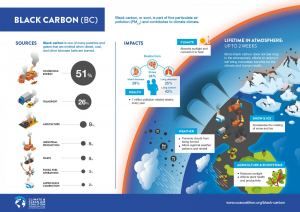
- SARS -CoV2
Context: WHO renames SARS-CoV2 Variants.
Key Details:
- The WHO renamed the all the variants after India objected to the B.1.617 mutant of the novel coronavirus being termed an ‘Indian Variant’.
- The B.1.617.1 and B.1.617.2 variants of the COVID-19, first identified in India, has been named as ‘Kappa’ and ‘Delta’ respectively.
- An expert group convened by WHO has recommended labelling using letters of the Greek Alphabet, i.e., Alpha, Beta, Gamma, which will be easier and more practical to discuss by non-scientific audiences.
- The established nomenclature systems for naming and tracking SARS-CoV-2 genetic lineages by GISAID, Nextstrain and Pango are currently and will remain in use by scientists and in scientific research.

